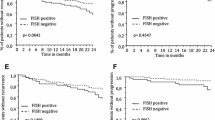Abstract
In the present study, different stages of transitional cell carcinoma of the bladder were analyzed by fluorescent in situ hybridization, using probes specific for pericentromeric classical satellite. Seventy primary tumors were evaluated for chromosomes 1, 7, 9, 17, and ploidy by flow cytometry. The results were correlated, after a mean follow-up period, with ploidy, histopathological characteristics, recurrence, and progression. Firstly, our data demonstrated that the sensitivity of fluorescence in situ hybridization in detecting quantitative DNA aberrations exceeds that of flow cytometry. The frequency of chromosome 1 and 9 aberrations was not significantly different in diploid and aneuploid tumors of different stage and grade. In contrast, the chromosome 7 and 17 aneusomy showed greater differences between pT1 and pT2-3 tumors (P<0.032 andP<0.0006, respectively) than between stage pTa and pT1. An increasing number of aberrations was observed in all chromosomes examined from tumors of patients that afterwards underwent cystectomy and/or had recurrent tumors. This study indicates that fluorescence in situ hybrization could be used to detect genetic changes relevant to patient outcome. These genetic changes could identify patients at high risk of recurrence and possible progression.
Similar content being viewed by others
References
Heney NM, Ahmed S, Flanagan MJ, et al. Superficial bladder cancer: progression and recurrence. J Urol 1983; 130:1083.
Kaye KW, Lange PH. Mode of presentation of invasive bladder cancer: reassessment of the problem. J Urol 1982; 128:31.
Hermanek P, Sobin LH. UICC-International Union Against. Cancer TNM classification of malignant tumors. Heidelberg Berlin New York: Springer-Verlag; 1987: 133.
Hopman AH, Moesker O, Smeets AW, et al. Numerical chromosome 1,7,9, and 11 alterations in bladder cancer detected by in situ hybridization. Cancer Res 1991; 51:646.
Tsai YC, Nichols PW, Hiti AL, et al. Allelic losses of chromosomes 9,11 and 17 in human bladder cancer. Cancer Res 1990; 50:44.
Klein E, Chaganti RSK. Genetics of transitional cell. Semin Surg Oncol 1992; 8:260.
Sauter G, Gasser TC, Moch H, Richter J, Jiang F, et al. DNA aberrations in urinary bladder cancer detected by flow cytometry and FISH. Urol Res 1997; 25:37.
Hermanek P, Sobin LH. UICC TNM classification of malignant tumours, 4th edn. New York Berlin Heidelberg: Springer-Verlag, 1992.
Cianciulli AM, Leonardo F, Bovani R, Gentili G, Gandolfo GM, Iori F, Leonardo C, Laurenti C. Chromosome 7 and 17 aneusomy: cytogenetic markers of bladder cancer progression detected by in situ hybridization. Acta Urol Ital 1998; 12:325.
Adshed JM, Kessingl AM, Ogden CW. Genetic initiation, progression and prognostic markers in transitional cell carcinoma of the bladder: a summary of the structural and transcriptional changes, and the role of developmental genes. Br J Urol 1998; 82:503.
Orntoft TF, Wolf H. Molecular alterations in bladder cancer. Urol Res 1998; 26:223.
Keen AJ, Knowles MA. Definition of two regions of deletion on chromosome 9 in carcinoma of the bladder. Oncogene 1994; 9:2083.
Linnenbach AJ, Pressler LB, Seng BA, Kimmel BS, Tomaszewski JE, Malkowicz SB. Characterization of chromosome 9 deletions in transitional cell carcinoma by microsatellite assay. Hum Mol Genet 1993; 2:1407.
Dalbagni G, Presti J, Reuther V, Fair WR, Cardon-Cardo C. Genetic alterations in bladder cancer. Lancet 1993; 342:469.
Vageli D, Kiaris H, Delakas D, Anezinis P, Cranidis A, Spandidos DA. Transcriptional activation of H-Ras, K-Ras and N-Ras proto-oncogenes in human bladder tumors. Cancer Lett 1996; 107:241.
Sandberg AA, Berger CS. Review of chromosome studies in urological tumors. Cytogenetics and molecular genetics of bladder cancer. J Urol 1994; 151:545.
Pycha A, Mian C, Haitel A, Hofbauer J, Wiener H, Marberger M. Fluorescence in situ hybridization identifies more aggressive types of primarily noninvasive (stage pTa) bladder cancer. J Urol 1997; 157:2116.
Spruck C, Ohneseit PF, Gonzales-Zulueta M. Two molecular pathways to transitional cell carcinoma of the bladder. Cancer Res 1994; 54:784.
Li B, Kanamaru H, Noriki S, Fukuda M, Okada K. Numeric aberration of chromosome 17 is strongly correlated with p53 overexpression, tumor proliferation and histopathology in human bladder cancer. Int J Urol 1998; 5:317.
Zhang FF, Arber DA, Wilson TG, Kawachi MH, Slovak ML. Toward the validation of aneusomy detection by fluorescence in situ hybridization in bladder cancer: comparative analysis with cytology, cytogenetics, and clinical features predicts recurrence and defines clinical testing limitations. Clin Cancer Res 1997; 3:2317.
Hall RR. Bladder preserving treatment: the role of transurethral surgery alone and with combined modality therapy for muscle-invading bladder cancer. In: Vogelzang NJ, Scardino PT, Shipley WU, eds. Comprehensive textbook of genitourinary oncology. Baltimore: Williams and Wilkins; 1995: 509.
Author information
Authors and Affiliations
Rights and permissions
About this article
Cite this article
Cianciulli, A.M., Bovani, R., Leonardo, F. et al. Interphase cytogenetics of bladder cancer progression: relationship between aneusomy, DNA ploidy pattern, histopathology, and clinical outcome. Int J Clin Lab Res 30, 5–11 (2000). https://doi.org/10.1007/s005990070026
Received:
Accepted:
Issue Date:
DOI: https://doi.org/10.1007/s005990070026




